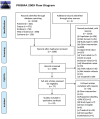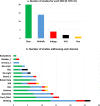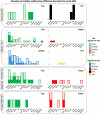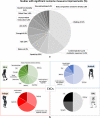Overground robotic training effects on walking and secondary health conditions in individuals with spinal cord injury: systematic review
- PMID: 35292044
- PMCID: PMC8922901
- DOI: 10.1186/s12984-022-01003-9
Overground robotic training effects on walking and secondary health conditions in individuals with spinal cord injury: systematic review
Abstract
Overground powered lower limb exoskeletons (EXOs) have proven to be valid devices in gait rehabilitation in individuals with spinal cord injury (SCI). Although several articles have reported the effects of EXOs in these individuals, the few reviews available focused on specific domains, mainly walking. The aim of this systematic review is to provide a general overview of the effects of commercial EXOs (i.e. not EXOs used in military and industry applications) for medical purposes in individuals with SCI. This systematic review was conducted following the PRISMA guidelines and it referred to MED-LINE, EMBASE, SCOPUS, Web of Science and Cochrane library databases. The studies included were Randomized Clinical Trials (RCTs) and non-RCT based on EXOs intervention on individuals with SCI. Out of 1296 studies screened, 41 met inclusion criteria. Among all the EXO studies, the Ekso device was the most discussed, followed by ReWalk, Indego, HAL and Rex devices. Since 14 different domains were considered, the outcome measures were heterogeneous. The most investigated domain was walking, followed by cardiorespiratory/metabolic responses, spasticity, balance, quality of life, human-robot interaction, robot data, bowel functionality, strength, daily living activity, neurophysiology, sensory function, bladder functionality and body composition/bone density domains. There were no reports of negative effects due to EXOs trainings and most of the significant positive effects were noted in the walking domain for Ekso, ReWalk, HAL and Indego devices. Ekso studies reported significant effects due to training in almost all domains, while this was not the case with the Rex device. Not a single study carried out on sensory functions or bladder functionality reached significance for any EXO. It is not possible to draw general conclusions about the effects of EXOs usage due to the lack of high-quality studies as addressed by the Downs and Black tool, the heterogeneity of the outcome measures, of the protocols and of the SCI epidemiological/neurological features. However, the strengths and weaknesses of EXOs are starting to be defined, even considering the different types of adverse events that EXO training brought about. EXO training showed to bring significant improvements over time, but whether its effectiveness is greater or less than conventional therapy or other treatments is still mostly unknown. High-quality RCTs are necessary to better define the pros and cons of the EXOs available today. Studies of this kind could help clinicians to better choose the appropriate training for individuals with SCI.
Keywords: Exoskeleton; Outcome measures; Rehabilitation; Robotic; Spinal cord injury.
© 2022. The Author(s).
Conflict of interest statement
The Authors declare that they have no competing interests.
Figures






Similar articles
-
Exoskeletons' design and usefulness evidence according to a systematic review of lower limb exoskeletons used for functional mobility by people with spinal cord injury.Disabil Rehabil Assist Technol. 2016 Oct;11(7):535-47. doi: 10.3109/17483107.2015.1080766. Epub 2015 Sep 4. Disabil Rehabil Assist Technol. 2016. PMID: 26340538
-
A rapid and systematic review of the clinical effectiveness and cost-effectiveness of topotecan for ovarian cancer.Health Technol Assess. 2001;5(28):1-110. doi: 10.3310/hta5280. Health Technol Assess. 2001. PMID: 11701100
-
Home treatment for mental health problems: a systematic review.Health Technol Assess. 2001;5(15):1-139. doi: 10.3310/hta5150. Health Technol Assess. 2001. PMID: 11532236
-
Measures implemented in the school setting to contain the COVID-19 pandemic.Cochrane Database Syst Rev. 2022 Jan 17;1(1):CD015029. doi: 10.1002/14651858.CD015029. Cochrane Database Syst Rev. 2022. Update in: Cochrane Database Syst Rev. 2024 May 2;5:CD015029. doi: 10.1002/14651858.CD015029.pub2. PMID: 35037252 Free PMC article. Updated.
-
Interventions for the treatment of brain radionecrosis after radiotherapy or radiosurgery.Cochrane Database Syst Rev. 2018 Jul 9;7(7):CD011492. doi: 10.1002/14651858.CD011492.pub2. Cochrane Database Syst Rev. 2018. PMID: 29987845 Free PMC article.
Cited by
-
The Effectiveness of Overground Robot Exoskeleton Gait Training on Gait Outcomes, Balance, and Motor Function in Patients with Stroke: A Systematic Review and Meta-Analysis of Randomized Controlled Trials.Brain Sci. 2024 Aug 19;14(8):834. doi: 10.3390/brainsci14080834. Brain Sci. 2024. PMID: 39199525 Free PMC article. Review.
-
User-centered design of a personal-use exoskeleton: a clinical investigation on the feasibility and usability of the ABLE Exoskeleton device for individuals with spinal cord injury to perform skills for home and community environments.Front Neurosci. 2024 Sep 26;18:1437358. doi: 10.3389/fnins.2024.1437358. eCollection 2024. Front Neurosci. 2024. PMID: 39391753 Free PMC article.
-
Dosing overground robotic gait training after spinal cord injury: a randomized clinical trial protocol.Trials. 2024 Oct 18;25(1):690. doi: 10.1186/s13063-024-08503-0. Trials. 2024. PMID: 39425122 Free PMC article.
-
Bilateral tibial fractures associated with powered exoskeleton use in complete spinal cord injury - a case report & literature review.Spinal Cord Ser Cases. 2024 Apr 16;10(1):22. doi: 10.1038/s41394-024-00635-4. Spinal Cord Ser Cases. 2024. PMID: 38627367 Free PMC article. Review.
-
Efficacy of Overground Robotic Gait Training on Balance in Stroke Survivors: A Systematic Review and Meta-Analysis.Brain Sci. 2022 May 31;12(6):713. doi: 10.3390/brainsci12060713. Brain Sci. 2022. PMID: 35741599 Free PMC article. Review.
References
-
- International Spinal Cord Society WHO. International Perspectives on Spinal Cord Injury Jerome Bickenbach, editor. 2013.
-
- Tamburella F. Gait Recovery in spinal cord injury subjects: From clinical experience to research developments. Sundhedsvidenskabelige Fakultet: Aalborg Universitet. Aalborg University; 2015.
-
- Anderson KD. Targeting recovery: priorities of the spinal cord-injured population. J Neurotrauma. 2004;21:1371–1383. - PubMed
-
- Ditunno PL, Patrick M, Stineman M, Morganti B, Townson AF, Ditunno JF. Cross-cultural differences in preference for recovery of mobility among spinal cord injury rehabilitation professionals. Spinal Cord. 2006;44:567–575. - PubMed
Publication types
MeSH terms
LinkOut - more resources
Full Text Sources
Medical
Miscellaneous

